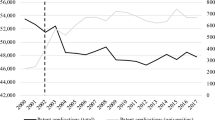Abstract
Commercial success in universities in the USA and Canada has resulted in many other countries taking steps to emulate this performance and major technology transfer and commercialisation support programmes have been launched in UK, Europe, Australia, Japan and many other countries—including South Africa. Unrealistic expectations have, however, been generated by the spectacular successes of a relatively few institutions and it is not always realised that the success from commercialisation is proportional to the magnitude of the investment in research. Without a well funded, high quality research system, it is not possible for technology transfer to make any significant contribution to economic development. The possible economic returns to higher education institutions from commercialisation of research can be estimated using international benchmarks. This forecast uses a combination of an institutional return on investment model and a simple economic projection. The model is generic and can be adapted for use in any institution. As more data becomes available from local (and international) sources, the model will be refined to give better estimates. The model is dynamic and shows, quantitatively, why it can take up to 10 years for an institution, and 20 years nationally, to attain a positive rate of return from an investment in research and technology transfer. The model enables the long-term impact of policy decisions, in an institution and nationally, to be examined and alternative scenarios explored. The performance of individual institutions is, however, highly variable and unpredictable. This is even for those institutions that are comparable in size and maturity. A large portfolio of patents and licences is required to give a reasonable probability of positive returns. This may be possible at a national level, but is problematic in smaller institutions—and smaller countries. Because the benefits of the innovation system are captured largely at national level, with institutions having a high uncertainty, public sector support to reduce the institutional risk is necessary to assist institutions to make the necessary investments. Technology transfer is of course only one element of the overall research and innovation value chain. All elements must be functioning effectively to derive the economic and social benefits from research. In addition to a strong research system, adequate incentives must exist to encourage academics to participate, particularly with regard to the crucial initial step of invention disclosure. After disclosure, sufficient institutional capacity must be in place to take an idea, evaluate it, protect the intellectual property appropriately and then seek a path to commercialisation through either licensing or start-up company formation.
Similar content being viewed by others
References
AUTM Association of University Technology Managers, FY 1999, FY 2000, FY 2001 and FY 2002, Licensing Surveys.
CENIS, 2002, South African S&T Indicators, Centre for Interdisciplinary Studies: University of Stellenbosch.
Geist, D., 1995, Pre-Production Investment and Jobs Induced by Technology Licensing: The M.I.T. Method, Technology Licensing Office, Massachusetts Institute of Technology.
Lundvall, B.-A., 2001, ‘Learning-by-Comparing—Reflections on the Use and Abuse of International Benchmarking’, in B.-A. Lundvall and M. Tomlinson, in Chapter 8 in Sweeney, G. (ed.), Innovation, Economic Progress and the Quality of Life, Elgar Publishers.
Marsili, O. and A. Salter, 2003, Is Innovation ‘Democratic’?, Skewed Distributions and the Returns to Innovation in Dutch Manufacturing, ECIS—Eindhoven Centre for Innovation Studies: Eindhoven University of Technology.
Pressman, L., 2002, ‘What is Known and Knowable about the Economic Impact of University Technology Transfer Programs’, Research Universities as Tools For Economic Development, Council on Research Policy and Graduate Education, NASULCG Annual Meeting, Chicago.
F.M. Scherer D. Harhoff (2000) ArticleTitle‘Technology Policy for a World of Skew-Distributed Outcomes’ Research Policy 29 559–566 Occurrence Handle10.1016/S0048-7333(99)00089-X
Tornatzky, L.G., 2000, Building State Economies by Promoting University-Industry Technology Transfer, National Governors’ Association.
Zeitlyn, M. and J. Horne, 2002, Business Interface Training Provision (BITS) Review, Final Report for the Department of Trade & Industry, UK Oakland Innovation and Information Services Ltd.
Author information
Authors and Affiliations
Corresponding author
Rights and permissions
About this article
Cite this article
Heher, A.D. Return on Investment in Innovation: Implications for Institutions and National Agencies*. J Technol Transfer 31, 403–414 (2006). https://doi.org/10.1007/s10961-006-0002-z
Issue Date:
DOI: https://doi.org/10.1007/s10961-006-0002-z




